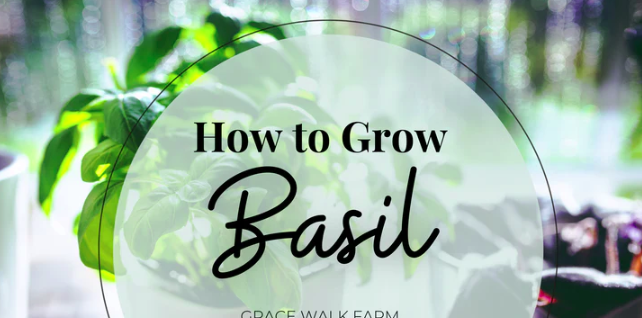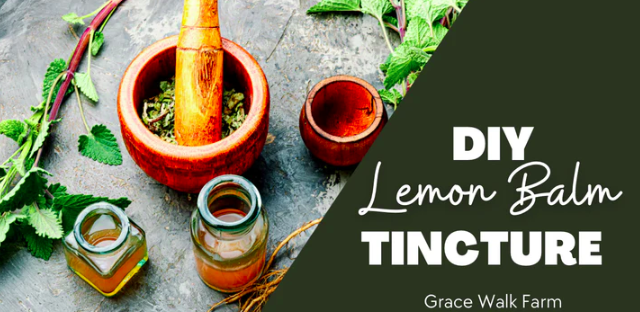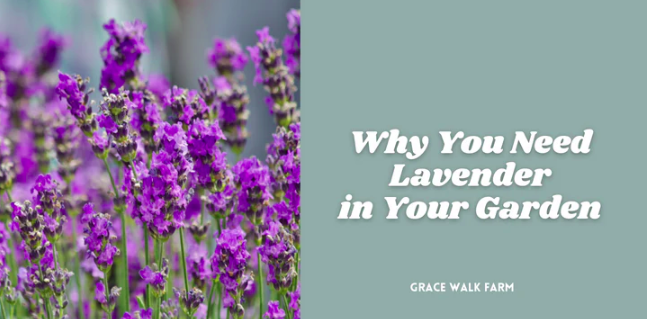Today, we’re going to explore the wonderful world of growing basil! If you love cooking and want to add some fresh, aromatic flavor to your dishes, then you definitely want to learn how to grow basil. It’s one of the most versatile and easy-to-grow herbs out there, and it’s a great choice for both experienced gardeners and beginners alike.
Welcome to Grace Walk Farm, our family homestead in western NC. We share the highs and lows of our homestead journey, in hopes that it will encourage you to grow your own food too. Click here to grab our Beginner Garden Guide for free! Join our 600K strong Instagram community of homesteaders here. Thanks for stopping by!
In this article, we’ll cover everything you need to know to grow healthy and delicious basil plants, from selecting the right variety to caring for your plants and harvesting your own fresh basil leaves. So, grab your gardening gloves and let’s get started on this delicious adventure!

How to Grow Basil
Basil is a warm-weather herb that thrives in hot and sunny conditions. It’s also an annual plant, which means it completes its life cycle in one season. Here are some tips to help you grow healthy and abundant basil.
Choose the right location: Basil needs plenty of sunlight, so choose a location in your garden that gets at least 6 hours of direct sun per day.
Prepare the soil: Basil prefers well-drained soil that is rich in organic matter. You can improve the soil by adding compost or well-rotted manure.
Plant the seeds or seedlings: Basil can be grown from seed or seedlings. If you’re starting from seed, plant them in early spring after the last frost. If you’re using seedlings, plant them after the danger of frost has passed.
Water regularly: Basil needs consistent moisture to grow well. Water it deeply once or twice a week, depending on the weather.
Fertilize sparingly: Basil doesn’t need a lot of fertilizer, but you can give it a boost by adding a balanced fertilizer once a month.
Pinch off the flowers: When basil flowers, it tends to produce less foliage and the leaves can become bitter. Pinch off the flowers as soon as you see them to encourage more leaf growth.

How to Prune Basil
Pruning basil is an important part of maintaining a healthy and productive basil plant. Here are some simple steps to follow when pruning your basil:
- Identify the stem to prune: Look for a stem that has developed several sets of leaves. This is usually the main stem of the plant.
- Locate the leaf node: A leaf node is the point where a leaf attaches to the stem. It’s important to prune just above the leaf node, as this will encourage new growth and prevent the plant from becoming too tall and leggy.
- Make the cut: Using a sharp pair of scissors or pruning shears, make a clean cut just above the leaf node. Be careful not to damage any other stems or leaves while pruning.
- Repeat: Continue pruning the basil plant as it grows, focusing on the main stem and any other stems that are developing multiple sets of leaves.
By following these simple steps, you can keep your basil plant healthy and productive throughout the growing season.
And don’t worry – basil is a hardy plant that can handle a good amount of pruning without harm. So feel free to prune away and enjoy the delicious, fresh flavor of homegrown basil!

How to Grow Basil from a Cutting
Growing basil from a cutting is a simple and effective way to propagate new plants. Here are the steps to follow:
- Choose a healthy basil plant: Find a mature and healthy basil plant that you would like to take cuttings from.
- Take cuttings: Using a clean and sharp pair of scissors or pruning shears, cut a 4-6 inch stem from the basil plant just below a leaf node. Make sure the cutting has at least 2-3 sets of leaves.
- Remove the lower leaves: Remove the lower leaves from the cutting, leaving only the top few sets of leaves.
- Prepare the cutting: Dip the end of the cutting in rooting hormone (optional) and shake off any excess. Then, place the cutting in a small container filled with water or moist soil. If using water, make sure to change it every 2-3 days to prevent it from becoming stagnant.
- Provide the right conditions: Place the container in a warm and bright location, but not in direct sunlight. Keep the soil moist, but not waterlogged. Within a week or two, the cutting should begin to form roots.
- Transplant the cutting: Once the cutting has developed a good set of roots, it’s time to transplant it into a larger pot or into the ground. Make sure to keep the soil moist and the plant well-watered until it is established.
That’s it! With a little patience and care, you can easily grow basil from cuttings and enjoy fresh herbs all season long.

Health Benefits of Basil
Basil is not only a delicious herb but also has many health benefits. Here are some of the most notable health benefits of basil:
- Anti-inflammatory properties: Basil contains essential oils such as eugenol, which have anti-inflammatory properties. These oils can help reduce inflammation in the body and alleviate symptoms of conditions such as arthritis.
- Antimicrobial properties: Basil also has antimicrobial properties that can help fight bacteria, viruses, and other pathogens. It’s been used traditionally to treat infections and may have potential as a natural antibiotic.
- Rich in antioxidants: Basil is rich in antioxidants such as flavonoids and phenolic compounds, which can help protect the body against damage from free radicals. These compounds may also have anti-cancer properties.
- Supports digestion: Basil can also help support digestion by promoting the production of digestive enzymes. It can also help soothe stomach discomfort and reduce bloating.

Ways to Use and Preserve Basil
Basil is a versatile herb that can be used in a variety of dishes, from salads and sauces to pizzas and pasta dishes. Here are some ways to use and preserve basil.
Fresh: Fresh basil is perfect for adding flavor to salads, sandwiches, and pizzas. Simply chop the leaves and sprinkle them on top of your favorite dish.
Pesto: Pesto is a classic Italian sauce made with basil, pine nuts, garlic, olive oil, and Parmesan cheese. It’s delicious on pasta, sandwiches, and as a dip.
Infused oil: Basil-infused oil is a great way to preserve the flavor of fresh basil. Simply heat olive oil and fresh basil in a saucepan, strain out the leaves, and store the oil in a clean jar.
Freeze: You can also freeze fresh basil to preserve it for later use. Simply chop the leaves, pack them into ice cube trays, and fill with water or olive oil. Once frozen, transfer the basil cubes to a freezer-safe container and store for up to 6 months.
Drying: Drying basil is another way to preserve its flavor for later use. Simply tie the basil leaves together in small bunches and hang them upside down in a cool, dry place. Once the leaves are dry and crumbly, remove them from the stems and store in an airtight container.

Benefits of Basil in the Garden
In addition to its culinary and health benefits, basil can also benefit your garden in several ways. Here are some of the benefits of growing basil in your garden:
Pest control: Basil has natural insect-repelling properties that can help protect your garden from pests such as mosquitoes, flies, and aphids. Planting basil near other plants can help deter these pests and reduce the need for chemical pesticides.
Attract pollinators: Basil produces small, fragrant flowers that can attract pollinators such as bees and butterflies to your garden. This can help promote the growth of other plants and increase the overall biodiversity of your garden.
Companion planting: Basil is a great companion plant for other herbs and vegetables, such as tomatoes and peppers. It can help repel pests and improve the flavor and growth of these plants.
Aesthetic value: Lastly, basil is a beautiful plant that can add color and texture to your garden. Its green leaves and delicate flowers can create a lush and fragrant atmosphere that is both relaxing and inviting.
Basil is a versatile and easy-to-grow herb that has numerous health benefits, culinary uses, and benefits for your garden. Whether you’re adding it to your favorite pasta dish or using it to repel pests in your garden, basil is a plant that can enhance your life in many ways.
So why not give it a try and start growing your own basil today? Your taste buds and your garden will thank you!
Also check out these blogs:




